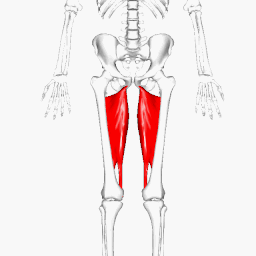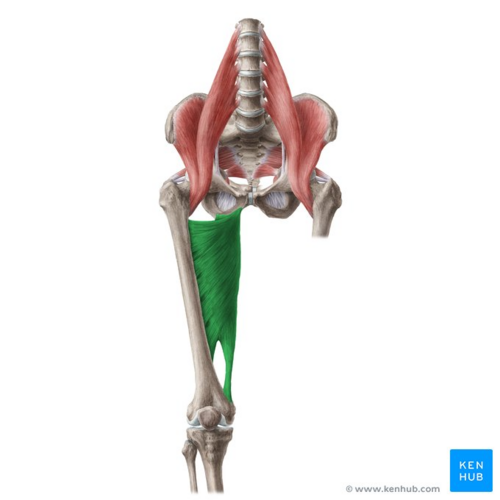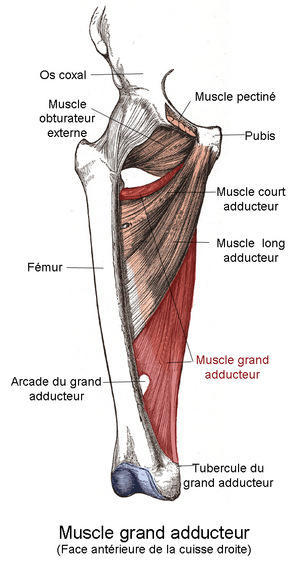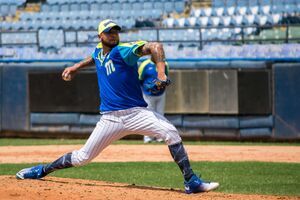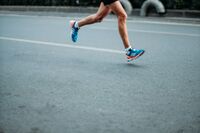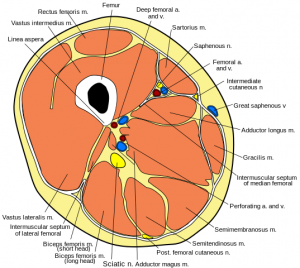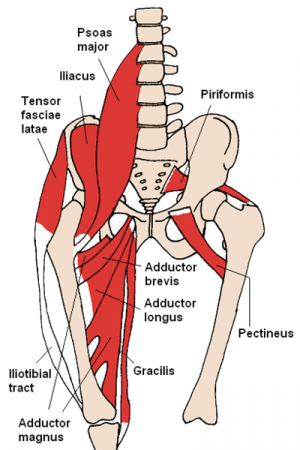Adductor Magnus
Original Editor - Vidya Acharya
Top Contributors - Vidya Acharya, Kim Jackson, Lucinda hampton and Joao Costa
Description[edit | edit source]
The Adductor Magnus muscle is one of hip adductors. The adductor magnus is the largest, most powerful and the most complex, of the adductor group. This muscle is complex in that part derived from the fact that it divides into an adductor (pubofemoral) portion and a hamstring (ischiocondylar) portion. It lies deep to the adductor brevis and the adductor longus.[1]
The adductor magnus muscle has a dual role being a dynamic stabilizer of the pelvis and femur as well as a prime mover of the femur into adduction.
The adductor magnus is similar to the deltoid muscle in that:
- One portion flexes the thigh and works as a medial rotator
- Another extends the thigh and is a lateral rotator
- Both portions adduct the thigh.
Anatomy[edit | edit source]
Origin[edit | edit source]
- The part of the muscle that is considered the adductor portion has its proximal attachment on the inferior ramus of the pubis and the ramus of the ischium.
- The part of the muscle considered the hamstring portion has its proximal attachment on the ischial tuberosity.
Each portion of the muscle has separate and distinct distal attachment points.[1] [2]
Image: Adductor magnus muscle (highlighted in green) - anterior view[3]
Insertion[edit | edit source]
Adductor part: posterior surface of proximal femur, middle of linea aspera, medial supracondylar line
Hamstring part: adductor tubercle of medial condyle of femur and supracondylar line.[2]
Nerve Supply[edit | edit source]
Adductor part: obturator nerve (L2-L4)
Hamstring part: sciatic nerve (L4-S1)[4]
Action[edit | edit source]
Its most basic function is to adduct and medially rotate the thigh at hip joint. Its functional roles are listed below.
The adductor magnus muscle is both a dynamic stabilizer of the pelvis and femur as well as a prime mover of the femur into adduction.
- The adductor magnus plays a similar function to the deltoid muscle; one portion flexes the thigh and works as a medial rotator while the other extends the thigh and is a lateral rotator, and both portions adduct the thigh. The anterior fibres which originate from the rami of pubis and ischium may assist in flexion, while the posterior fibres that arise from the ischial tuberosity may assist in extension.[2] The adductor magnus has a large hip extensor muscle moment arm, making it an unappreciated hip extensor. The hip extension moment arm length of the adductor magnus changes with hip angle and it is a more effective hip extensor than either the hamstrings or gluteus maximus when the hip is flexed. The peak contractions of the muscle are seen in positions of hip flexion for eg. full squats.[5]
- The curvilinear attachment of the adductor magnus on the pelvis is like the attachment of the deltoid on the spine of the scapula, acromion, and clavicle. Both muscles serve as dynamic stabilizers of the ball and socket joints (shoulder or hip, respectively). [1][2]
Blood Supply[edit | edit source]
Adductor magnus is supplied[6] by the:
- obturator artery
- femoral artery
- medial femoral circumflex
- direct and perforating branches of the deep femoral artery.
Physiotherapy Relevance[edit | edit source]
- Adductor tendinopathy is a common cause of groin injury and pain among athletes. They are seen mostly in athletes, ice hockey, and football players[7]. Predominant in male athletes. The source of groin pain is difficult to diagnose due to the involvement of many muscles; hip adductors and gluteals and also due to proximity to the pelvis, hip joint and sacrum[8].
- Knee Joint pain
Tight adductors can cause knee pain, especially seen in runners. The function of the adductor muscles is to pull the thighs together and rotate the upper leg inwards, as well as stabilizing the hip.
- The adductor magnus appears to display a relatively mixed muscle fibre type proportion[9], albeit with a greater proportion of type I muscle fibres.
- Postural (type 1)[10] have the tendency to shorten when chronically stressed.
- These muscles may be torn at their origin from the pelvis or in their bulk on the inside of the thigh[11].
Adductor Canal Compression Syndrome
Adductor canal syndrome is an unusual cause of acute arterial occlusion in younger men. It is the result of arterial compression by an abnormal musculotendinous band arising from the adductor magnus muscle and lying adjacent and superior to the adductor tendon.[12]
Near the base of the adductor magnus muscle is the adductor hiatus which is the terminal portion of the adductor canal. The canal serves as a passageway from structures moving between the anterior thigh and posterior leg ( the femoral artery, femoral vein, nerve to the vastus medialis and the saphenous nerve).[13][4]
Assessment[edit | edit source]
Palpation
The tendon of Adductor Longus is the most proximal tendon amongst the adductors of the hip joint, Gracilis is medial to the Adductor Longus. Adductor Magnus lies posterior to Gracilis muscle[14]. Adductor Magnus is palpated on the medial aspect of the thigh while resisting the hip adduction against resistance and feeling for the engagement of the musculature.
Power
Position: Side-lying.
Test: Adduction of the underneath extremity from the table without rotation, flexion, or extension of the hip, or tilting of the pelvis. Strength is graded by pressure applied over the medial aspect of the thigh in the direction of abduction i.e downward towards the thigh.[2]
Length
Insufficient length of muscles results in contracture of the hip adductors or hip adduction deformity.
In standing, the pelvis is laterally tilted, it is high on the side of contracture; making it necessary to plantarflex the foot on the same side so that toes touch the ground. As an alternative, if the foot is flat on the floor, the opposite extremity is either flexed at hip joint or abducted in-order to compensate for the apparent shortness of the adducted side.[2]
Treatment[edit | edit source]
Examples listed below
Stretching exercises to maintain the length of the muscle:
The long adductors stretch
- Stand and open the legs to a wide stance.
- Flex the opposite knee leaning to this side until the stretch is felt
- Hold for 20-30 seconds
Frog Pose[edit | edit source]
Myofascial Release[edit | edit source]
Strengthening Exercises[edit | edit source]
Various exercises can strengthen the Adductor Magnus muscle:
Isometric adduction with knees bent[edit | edit source]
One study by Lovell et al. (2012) explored a number of common rehabilitation tests for the adductors and found that the supine isometric hip adduction in 0 or 45 degrees of hip and knee flexion were the best positions for producing maximal EMG amplitude in the adductor magnus[15]
Concentric adduction exercises[edit | edit source]
Resisted exercises with elastic band[edit | edit source]
Eccentric adduction exercises[edit | edit source]
A simple adduction strengthening programme based on Copenhagen Adduction Exercise reduced the risk of groin problem in footballer players according to this study published in British Journal of Sports Medicine. [17]
Resources[edit | edit source]
This 2 minute video is a good summary of the adductor magnus muscle.[18]
References[edit | edit source]
- ↑ 1.0 1.1 1.2 Jeno SH, Schindler GS. Anatomy, bony pelvis and lower limb, thigh adductor magnus muscles.Available: https://www.ncbi.nlm.nih.gov/books/NBK534842/(accessed 20.1.2022)
- ↑ 2.0 2.1 2.2 2.3 2.4 2.5 Kendall, McCreary, Provance; Muscle Testing and Function with Posture and Pain 4th Edition; Hip adductors; Page No.228.
- ↑ Adductor magnus muscle (highlighted in green) - anterior view image - © Kenhub https://www.kenhub.com/en/library/anatomy/adductor-magnus
- ↑ 4.0 4.1 Radiopedia Adductor Magnus Available: https://radiopaedia.org/articles/adductor-magnus-muscle(accessed 20.1.2022)
- ↑ https://www.strengthandconditioningresearch.com/muscles/adductors/#REF
- ↑ Ortho Bullets; Adductor magnus,https://www.orthobullets.com/anatomy/10067/adductor-magnus
- ↑ Ishøi L, Sørensen CN, Kaae NM, Jørgensen LB, Hölmich P, Serner A. Large eccentric strength increase using the Copenhagen Adduction exercise in football: A randomized controlled trial. Scandinavian journal of medicine & science in sports. 2016 Nov 1;26(11):1334-42.https://www.ncbi.nlm.nih.gov/pubmed/26589483
- ↑ Kujala UM, Taimela S, Antti-Poika I, Orava S, Tuominen R, Myllynen P. Acute injuries in soccer, ice hockey, volleyball, basketball, judo, and karate: analysis of national registry data. Bmj. 1995 Dec 2;311(7018):1465-8.https://www.ncbi.nlm.nih.gov/pubmed/19620912
- ↑ Science Direct, Adductor, The hip; Leon Chaitow ND DO, Judith DeLany LMT, in Clinical Application of Neuromuscular Techniques, Volume 2 (Second Edition), 2011 https://www.sciencedirect.com/topics/neuroscience/adductor-hiatus
- ↑ Adductors; Muscle Fibre Type; Adductor magnus https://www.strengthandconditioningresearch.com/muscles/adductors/#REF
- ↑ BODYWORKS: ADDUCTOR INJURIES https://www.runnersworld.co.uk/health/injury/bodyworks-adductor-injuries
- ↑ Verta MJ, Vitello J, Fuller J. Adductor canal compression syndrome. Archives of Surgery. 1984 Mar 1;119(3):345-6.Available: https://pubmed.ncbi.nlm.nih.gov/6696630/(accessed 20.1.2022)
- ↑ The Lower Limb/The Adductor Canal http://teachmeanatomy.info/lower-limb/areas/adductor-canal/
- ↑ Art of Kinesiology;Joe Muscolinohttps://learnmuscles.com/blog/2017/01/27/assess-diagnose-client-adductor-strain/
- ↑ Lovell GA, Blanch PD, Barnes CJ. EMG of the hip adductor muscles in six clinical examination tests. Physical Therapy in Sport. 2012 Aug 1;13(3):134-40.https://www.ncbi.nlm.nih.gov/pubmed/22814446
- ↑ eHowFitness How to Do Thigh Abduction & Adduction Exercises With Bands : Stretching & Exercise. Available from https://www.youtube.com/watch?time_continue=6&v=HE-8qeIZo3o
- ↑ Harøy J, Clarsen B, Wiger EG, Øyen MG, Serner A, Thorborg K, Hölmich P, Andersen TE, Bahr R. The Adductor Strengthening Programme prevents groin problems among male football players: a cluster-randomised controlled trial. Br J Sports Med. 2018 Jun 8:bjsports-2017.https://www.ncbi.nlm.nih.gov/pubmed/29891614
- ↑ Adductor magnus muscle video - © Kenhub https://www.kenhub.com/en/library/anatomy/adductor-magnus
